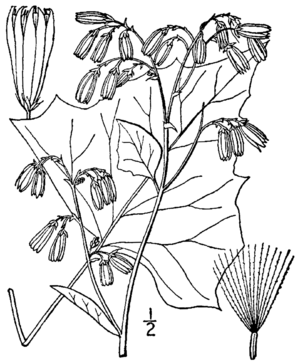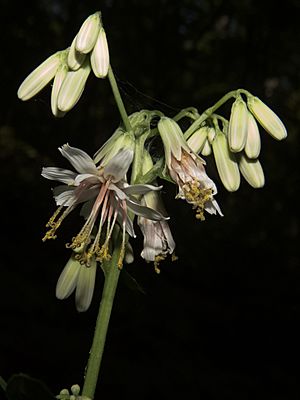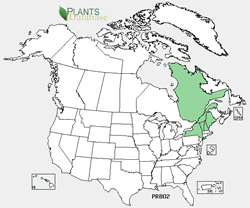White rattlesnake-root facts for kids
Quick facts for kids White rattlesnake-root |
|
|---|---|
 |
|
| Nabalus albus | |
| Scientific classification | |
| Genus: |
Nabalus
|
| Species: |
albus
|
| Synonyms | |
|
Prenanthes alba L. |
|
Nabalus albus, also known as the white rattlesnake-root, is a cool plant. People sometimes call it Boott's rattlesnake-root or white lettuce. It belongs to the Asteraceae family, which is a big group of flowering plants. You can find this plant growing naturally in Canada and the Eastern United States.
To tell Nabalus albus apart from other plants in its group (the Nabalus genus), you need to look closely at its flowers. Long ago, the Iroquois people used the roots of this plant. They would make a paste from the roots and put it on snake bites. This plant likes to grow in forests and woodlands. It can also be found in places changed by people, like along roadsides.
The flowers of the white rattlesnake-root are quite special. Each flower head has only "ray flowers." This means every tiny flower in the head looks like a strap or a ray. These rays can have small teeth at their tips. The flowers can be many colors, including blue, purple, pink, red, or white. The leaves of the plant can grow from about 40 to 300 millimeters long. The flower heads themselves are small, only 3 to 5 millimeters wide. In places like Missouri, the plant blooms from July to September. In 2010, scientists decided to move this plant from the Prenanthes group to the Nabalus group.
Where White Rattlesnake-Root Grows
The white rattlesnake-root is native to Canada and the Eastern United States. Its range stretches west into North Dakota and northeast Missouri. You can also find it in four counties in northwest Arkansas. It is very common in states like Connecticut, Maine, Massachusetts, New Hampshire, and Vermont.



